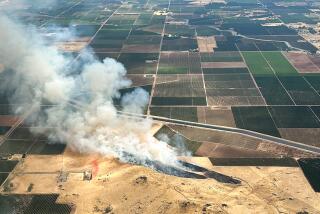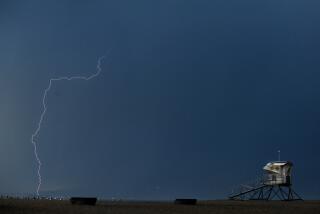More El Niño trouble: Thunderstorm sends rocks onto highway to Yosemite
After lashing Southern California this weekend, El Niñoâs strange weather has moved north -- hitting Yosemite National Park.
Yosemite was pelted by unusually wet thunderstorms Tuesday, prompting a mud and rock slide on Highway 140 leading to the parkâs western edge.
The debris, which fell from a hillside that burned during the El Portal fire last year, was so extensive that the road -- one of only three main routes to the park from the west -- remained closed until Thursday evening, when it reopened.
SIGN UP for the free Essential California newsletter >>
Tuesdayâs storms were only the latest in abnormally wet thunderstorms to hit Yosemite this summer.
âWhatâs unusual is that itâs the middle of the summer,â park spokeswoman Jodi Bailey said. âWe donât typically get a lot of rain over the summer, but over the last few weeks weâve had several good-sized rainstorms. ⦠Some of these are heavier than our typical afternoon thunderstorm.
âWe just donât typically have warm, muggy cloudy days with the big rainstorms like this,â Bailey said.
Itâs a big turnaround for Yosemite. The park had been so dry earlier this year that many expected waterfalls in the park to have dried up by this time. Last year, they were mostly dry by the end of June. With the latest storms, âtheyâre definitely flowing.â
âWe seem to be in interesting times, weather-wise,â Bailey said.
The thunderstorms over Yosemite were far richer in moisture than the typical summer mountain thunderstorm, said Gary Sanger, a National Weather Service meteorologist in Hanford.
âPart of the problem is that theyâve been so slow-moving,â Sanger said. âBecause theyâre slower-moving, you get heavier rain in one area.â
The same storm system brought a bit of winter near Lake Tahoe on Tuesday. A dramatic storm dumped 4 inches of hail on Interstate 80 around Donner Summit, forcing authorities to shut the road and call out the snowplows.
Tuesdayâs storms were caused by the remnants of a former hurricane, Dolores, whose arrival in Southern California last weekend caused such heavy downpours that an eastbound section of Interstate 10 between Palm Springs and Arizona washed away on Sunday. Authorities have reconfigured the westbound bridge to handle traffic in both directions.
The stormâs effects are still rolling through the West. âWeâre still getting some thunderstorms over central Nevada today. Itâs still that leftover moisture pulling out,â said Edan Weishahn, a meteorologist in the National Weather Serviceâs Reno office.
The number of tropical storms and hurricanes in the eastern Pacific Ocean is above average for this time of year, likely an effect of El Niño.
Warmer ocean temperatures allowed the ex-hurricane to make landfall in California with more moisture and strength than if the ocean was as cool as it normally is.
Already, there have been six tropical cyclone storms in the eastern Pacific powerful enough to get names, said Dennis Feltgen, spokesman for the National Weather Serviceâs National Hurricane Center in Miami.
On Thursday, a tropical storm was named Felicia in the eastern Pacific, several hundred miles southwest of Baja Californiaâs southern tip. Itâs the sixth of the season. But Felicia is headed away from land, and is already expected to weaken, Feltgen said.
The last time a hurricane threatened Southern California was in 1997, which came during the most powerful El Niño on record. Hurricane Linda -- at the time the most powerful on record in the eastern Pacific -- threatened to menace Southern California and make landfall in San Diego as a weak hurricane or strong tropical storm. But Linda shifted direction and headed west to sea.
A tropical storm struck Long Beach in September in the El Niño year of 1939. Before that, the last time a hurricane hit Southern California was in 1858, when hurricane-force winds struck San Diego and tropical-force winds hit Long Beach. Heavy rains flooded streets and homes in Los Angeles.
Hungry for more El Niño news? Follow me on Twitter: @ronlin
MORE ON EL NINO:
Q&A: El Niño could bring disaster and drought relief to California
Unusually strong July rains offer a preview of a robust El Niño
Graphic: Over 65 years, El Niño has affected California rainfall levels
More to Read
Sign up for Essential California
The most important California stories and recommendations in your inbox every morning.
You may occasionally receive promotional content from the Los Angeles Times.











